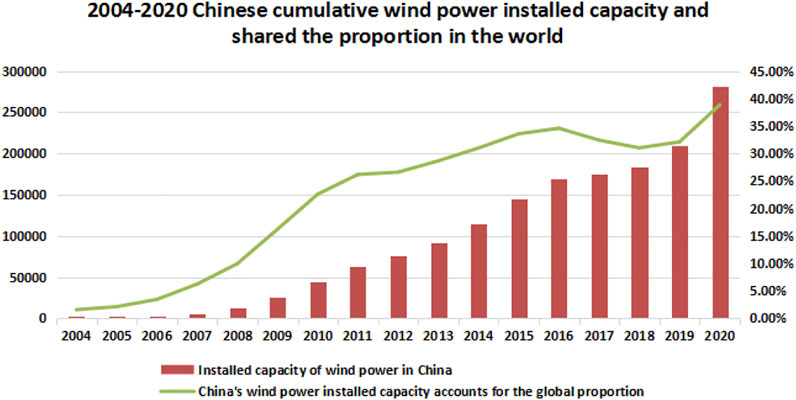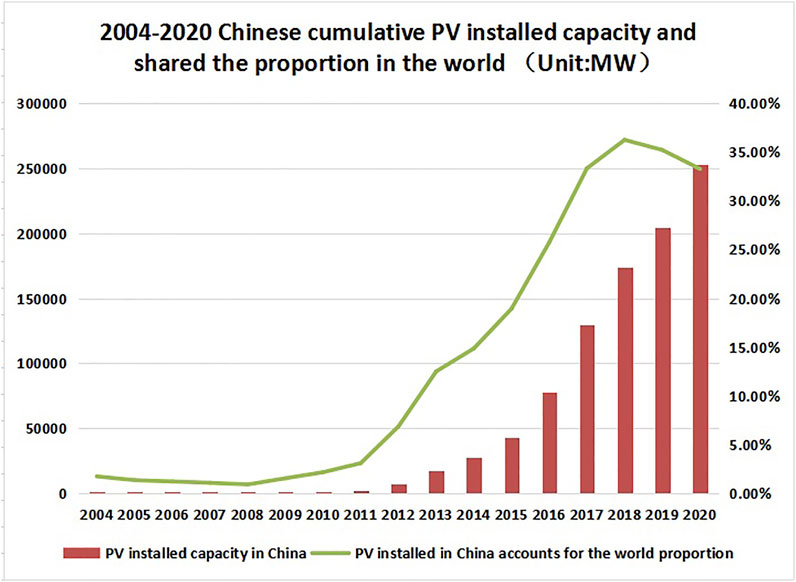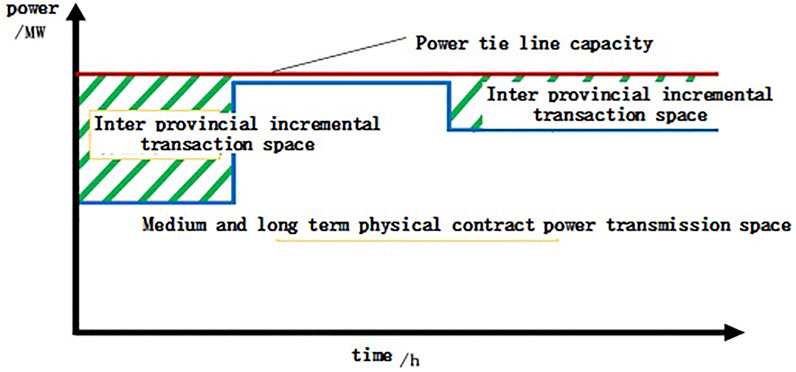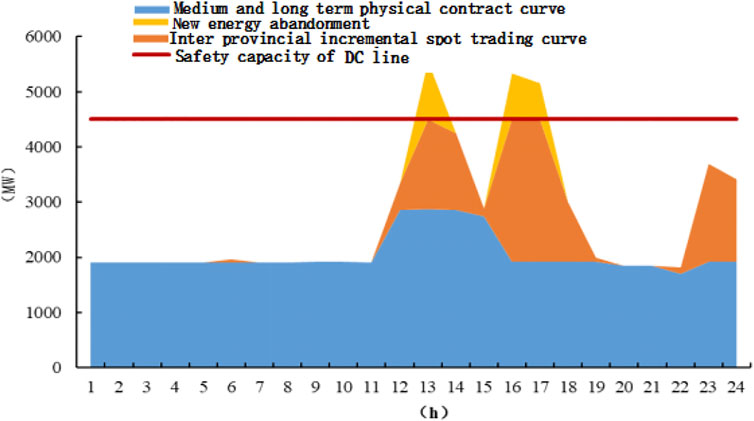- 1College of Electrical Engineering, Zhejiang University, Hangzhou, China
- 2Electric Power Research Institute, State Grid Gansu Electric Power Company, Lanzhou, China
In the past decade, China’s new energy has experienced a prosperous development and has become an important main power supply in China. With the promotion of China’s power market–oriented reform, the market-oriented transaction mechanism will play an essential role for China to achieve a large-scale and efficient national allocation of new energy. This study systematically analyzes and designs the principle of China’s new energy cross-provincial marketization mechanism, including those for a compound system such as an interprovincial medium and long-term transaction and spot transaction. The proposed mechanism is validated by its implemental results on a prototype power system with new energy.
Introduction
Building a new power system with new energy is a major strategic decision to promote the transformation and dispatching of clean energy in China. In the past decade, China’s new energy has experienced a prosperous development, and the installed new energy ranks one in the world. By December 2021, the total installed wind power and photovoltaic power has reached 600 million kW. In 2021, the commercially trading power is about 3.5 trillion kWh, with a year-by-year increase of 15.7%, taking more than 40% of the total power consumption of the whole society. The installed wind and photovoltaic powers in China and their proportion in the world from 2004 to 2020 are shown in Figure 1; Figure 2 respectively. As a result, the large-scale application of new energy has brought a series of challenges to a new power system in both technologies and applications.

FIGURE 1. Installed wind power in China and its proportion in the world from 2004 to 2020 (unit: MW).

FIGURE 2. Installed photovoltaic powers in China and its proportion in the world from 2004 to 2020 (unit: MW).
To address the challenges faced by an integrated power system with new energy, different efforts are reported in literature. To investigate the effect of energy storage systems on automatic generation control of interconnected traditional and restructured energy systems, a method based on a two-area non-reheat thermal power system with extra generation from a wind turbine system and dish stirling solar thermal system is proposed and validated (Arya, 2019). To improve wind power quality and stability, a closed-loop active power control of wind farm based on frequency domain is introduced in Chen et al. (2019). An environment-friendly and economical scheduling optimization for an integrated energy system considering power to gas technology and a carbon capture power plant is implemented in Zhang and Zhang (2020). A robust optimization approach for the integrated community energy system in energy and ancillary service markets is presented in Zhou et al. (2018). A deep reinforcement learning–based approach for optimizing energy conversion in an integrated electrical and heating system with renewable energy is investigated in Zhang et al. (2019). A general review on challenges faced by China compared with those by the US is detailed in Lu et al. (2016). A methodology for decentralized optimization of coordinated electrical and thermal generation in hierarchical integrated energy systems considering competitive individuals in developing wind power is proposed in Wang et al. (2018). The optimal operation of the integrated electricity–heat energy system considering flexible resources dispatch for renewable integration is comprehensively studied in Wang et al. (2021a). A study on energy management and optimization of vehicle-to-grid systems for wind power integration is conducted by Wang et al. (2020b). The socioeconomic viability of solar commercialization and electrification in South Asian countries is systematically assessed by Sun et al. (2021a). The role of technological innovation and knowledge spillover for energy efficiency utilization is investigated by Sun et al. (2021b).
From the aforementioned literature review it is obvious that there are a few literatures that are devoted to the commercialization of the new energy power system. In this point of view, this article studies China’s new energy cross-provincial marketization mechanism, based on the integration unification of existing ones, under the background of “Double Carbon”.
Interprovincial Transaction Mode
The general modes for the existing new energy cross-provincial transaction include the medium- and long-term physical contract and the cross-regional interprovincial incremental spot transaction. Cross-provincial and regional transactions of the new energy are mainly implemented through medium- and long-term transactions such as the forced annual priority power generation plan, interprovincial delivery transaction, and the power generation rights transaction.
Medium- and Long-Term Electricity Market Transaction Trading Mode
Annual Priority Generation Plan Mode
The annual priority power generation plan mode refers to the transaction of non-tradable electricity arranged in accordance with the national plan, intergovernmental agreements, and relevant policies and regulations.
Transaction Participants
It mainly includes large-scale wind power, photovoltaic power, and other new energy power generation enterprises covered by the national plan and the transmission and receiving end power grid companies.
Transaction Mode
It covers the medium- and long-term transactions and guarantees as secured in the contracts.
Electricity Pricing
Trans-provincial new energy transmission capacity shall be guaranteed in the annual trans-provincial priority power generation plan. The price will be set uniformly by the state government and approved for implementations.
Interprovincial Delivery Transaction
An interprovincial power transmission transaction refers to the tradable transaction of purchase and sale of power between power generation enterprises and power grids, or between the power transmission and receiving end power grids.
Transaction Participants
It consists of the wind power, photovoltaic power, and other new energy power generation enterprises and the transmission and receiving end power grid companies.
Transaction Mode
According to the transaction cycle, the transaction mode is generally divided into multiyear, annual, monthly, and monthly multi meat transactions. According to the transaction organization mode, it is generally divided into bilateral negotiation, centralized bidding, and listing to name a few.
Pricing
The trading power and price is determined by negotiation, declaration, and settlement by both parties.
Interprovincial Power Direct Transaction
An interprovincial power direct transaction refers to the transaction between direct participants of sending end new energy power plant, receiving end power users, and the power sales company. The power grid enterprises provide power transmission and distribution services according to the regulations. Generally, according to the release of the power generation and the consumption plan, some power is released in the annual interprovincial and regional annual power generation plan.
Transaction Participants
Transaction participants include the qualified sending end new energy power plants, the receiving end power users, the power sales companies, and the power grid enterprises.
Transaction Mode
There are mainly two applicable modes. The first is the bilateral negotiation mode between the sending end new energy power generation enterprise and the receiving end power users. The second is the commercially trading mode through the trading platform, including the centralized bidding, the listing trading mode, and so on. Power generation enterprises can choose to directly participate in the transaction or authorize their provincial power grid enterprises to participate in the market transaction.
Electricity Pricing
The region of the trans-provincial trading electricity is usually determined by the trading center in the annual trans-provincial power generation and utilization plan according to the liberalization of the trans-provincial power generation and utilization plan and national policies and regulations. The transaction price is determined through a bilateral negotiation, centralized bidding transaction, and listing transaction.
Interprovincial Power Generation Right Transaction
The interprovincial power generation right transaction, also known as the interprovincial contract transaction, refers to the paid transfer and purchase of the contracted electricity by the new energy power generation enterprises and other power generation enterprises through market-oriented approaches.
Transaction Participants
Transaction participants are the qualified new energy power generation enterprises and the thermal power generation enterprises.
Transaction Modes
The transaction is organized by the trading center, qualified new energy power generation enterprises, and thermal power generation enterprises by using the market-oriented approaches such as the bilateral negotiation and the centralized bidding through the trading platform.
Electricity Pricing
The transaction volume price of the power generation right is determined by both parties. In addition, at present, the transaction scale of the new energy power generation rights across provinces and regions is small.
Electricity Spot Trading Mode
The current cross-regional spot trading mainly refers to the cross-regional and interprovincial surplus renewable energy power spot trading.
Transaction Participants
The participants include the sending end new energy power plant, the hydropower plant, and the receiving end power grid company.
Transaction mode
Dispatching centers at all levels of the power grid company shall organize the sending end power generation enterprises and the receiving end power grid companies to apply for the centralized bidding and the unified clearing.
Pricing
Under the bidding mode, the volume and price before the day are uncertain, and the trading volume and price are determined according to the declaration and channel conditions of both parties. The intra-day price is determined according to the previous day price, and the trading volume is determined according to the declaration and channel conditions of both parties.
Interprovincial and Regional Spot Transaction Consumption Model
By using the time series production simulation method and taking the maximum consumption of new energy as the optimization objective, the new energy delivery capacity in the surplus region in each period of the tie line channel is optimized to determine the optimal trading volume of new energy in each period in the interprovincial incremental spot market, as shown in Figure 3.

FIGURE 3. Schematic diagram of interprovincial consumption under the mode of interprovincial incremental spot market.
The optimal objective of this model is to maximize the new energy consumption of the system. Mathematically, it is formulated as follows:
where T is the number of the scheduling cycle periods, N is the number of partitions of the whole system,
In the optimization, different constrains are also applied. The details are given as follows:
(1) Regional load balancing constraint
where
(2) Rotate alternate constraint
where
(3) Generation power constraint of the thermal power units
(4) Climbing rate constraint of the thermal power unit
where
(5) Power constraint of wind power and photovoltaic power generation
where
(6) Inter area transmission line capacity constraints
where
(7) System scheduling instruction constraints
where the variable is a 0–1 discrete variable.
(8) Tie line transmission security capacity constraint
This constraint means that the transmission power of the interprovincial tie lines cannot exceed the safe transmission capacity of the tie lines, and the surplus volume behind the medium- and long-term physical contract curve of the interprovincial tie lines can only be used to organize the interprovincial incremental spot transactions.
Simulation Verification
Based on the power system of the Gansu province in Northwest China in 2020, considering the development of the interprovincial incremental spot market on DC transmission lines, this study analyzes the effect of the medium- and long-term physical contract interprovincial incremental spot market mode on the new energy consumption.
Load
The power consumption is 112.6 billion kWh in 2020. The maximum load is 17.23 million kW in 2020.
Exchange of Electricity With Other Provinces
The exchange of electricity with the neighbor provinces is considered. In 2020, the exchange power of connecting lines between Gansu and other provinces is considered as the net transmission of 36 billion kWh, of which the net transmission of DC medium- and long-term physical contract is 18 billion kWh, and the maximum transmission/receiving capacity of DC is 5.5 million kW.
Thermal Power Installed Capacity
The total installed capacity of thermal power units is 20.86 million KW in 2020.
Hydropower Installed Capacity
The installed capacity of the adjustable hydropower is 2.95 million kW, the installed capacity of the runoff hydropower units is 6.95 million kW, and there is no pumped storage unit in 2020.
Wind Power
The total installed capacity of the centralized wind power in the province is 14.17 million kW, and the annual theoretical power generation utilization hours of the wind power is 2,100 h in 2020.
Photovoltaic Power
The total installed capacity of the centralized photovoltaic in the province is 9.84 million kW, and the theoretical utilization hours of the photovoltaic power generation in the whole year is 1,480 h in 2020.
The production simulation method is used to solve the annual consumption of new energy in the Gansu province after the implementation of the incremental spot market. Table 1 compares the annual consumption of new energy in the Gansu province before and after the implementation of the interprovincial incremental spot market transaction mode.

TABLE 1. Comparison of new energy consumption in the Gansu province before and after the interprovincial incremental spot market mode.
It can be seen from Table 1 that after the interprovincial incremental spot market transaction mode is implemented between the two provinces, the consumption and utilization level of new energy in the province has been significantly improved. When the interprovincial incremental spot market was not activated, the new energy power rationing rate of the province was 11.62%. After the interprovincial incremental spot market was activated, the new energy power rationing rate of the province decreased to 3.9%. Due to the interprovincial incremental spot market transaction, the consumption of new energy in the province increased by 3.111 billion kWh, and the increased power of new energy was sent out through the DC channel.
Figure 4 shows the transmission power of the Gansu Qishao DC interconnection line and the power limitation of new energy in the Gansu province on a special day after the implementation of the interprovincial incremental spot market.
It can be seen from Figure 4 that when the new energy abandonment occurs in the Gansu province, the new energy transmission capacity of the Gansu province can be improved by organizing an incremental spot transactions among provinces, to improve the utilization rate of new energy. Interprovincial incremental spot trading can make full use of the surplus capacity of the interprovincial transmission channels, which can not only improve the new energy utilization rate of transmission end provinces but also improve the channel utilization level.
Conclusion
Interprovincial incremental spot trading can make full use of the surplus capacity of the interprovincial transmission channels, which can not only improve the new energy utilization rate of transmission end provinces but also improve the channel utilization level. In case of new energy power abandonment, the incremental spot transactions between provinces can be organized to improve the export volume of new energy in the prototype province and also enhance the utilization rate of new energy in the province in question.
Data Availability Statement
The original contributions presented in the study are included in the article, further inquiries can be directed to the corresponding author.
Author Contributions
QZ: conceptualization, methodology, and original draft. JL: reviewing, and editing. QL: reviewing, and editing. DW: reviewing, and editing. SY: reviewing, and editing.
Funding
This research was supported by Gansu Youth Science and Technology Program (20JR5RA078) and the Fundamental Research Funds for Gansu Longyuan Innovation and Entrepreneurship Talent Project (“Research on Key Technologies of Wide Area Coordinated Optimal Control and High Throughput Based on Multisource Data Fusion Mining for High Proportion New Energy Base”).
Conflict of Interest
Authors QZ, JL, QL, and DW were employed by the company State Grid Gansu Electric Power Company.
The remaining authors declare that the research was conducted in the absence of any commercial or financial relationships that could be construed as a potential conflict of interest.
Publisher’s Note
All claims expressed in this article are solely those of the authors and do not necessarily represent those of their affiliated organizations, or those of the publisher, the editors, and the reviewers. Any product that may be evaluated in this article, or claim that may be made by its manufacturer, is not guaranteed or endorsed by the publisher.
References
Arya, Y. (2019). Effect of Energy Storage Systems on Automatic Generation Control of Interconnected Traditional and Restructured Energy Systems. Int. J. Energ. Res 43, 6475–6493. doi:10.1002/er.4493
Chen, Z., Liu, J., Lin, Z., and Duan, Z. (2019). Closed-Loop Active Power Control of Wind Farm Based on Frequency Domain Analysis. Electric Power Syst. Res. 170, 13–24. doi:10.1016/j.epsr.2019.01.003
Lu, X., McElroy, M. B., Peng, W., Liu, S., Nielsen, C. P., and Wang, H. (2016). Challenges Faced by China Compared with the US in Developing Wind Power. Nat. Energ. 1, 1–6. doi:10.1038/nenergy.2016.61
Sun, H., Awan, R. U., Nawaz, M. A., Mohsin, M., Rasheed, A. K., and Iqbal, N. (2021). Assessing the Socio-Economic Viability of Solar Commercialization and Electrification in South Asian Countries. Environ. Dev. Sustain. 23, 9875–9897. doi:10.1007/s10668-020-01038-9
Sun, H., Edziah, B. K., Kporsu, A. K., Sarkodie, S. A., and Taghizadeh-Hesary, F. (2021). Energy Efficiency: The Role of Technological Innovation and Knowledge Spillover. Technol. Forecast. Soc. Change 167, 120659. doi:10.1016/j.techfore.2021.120659
Wang, L., Jing, Z. X., Zheng, J. H., Wu, Q. H., and Wei, F. (2018). Decentralized Optimization of Coordinated Electrical and thermal Generations in Hierarchical Integrated Energy Systems Considering Competitive Individuals. Energy 158, 607–622. doi:10.1016/j.energy.2018.05.200
Wang, W., Huang, S., Zhang, G., Liu, J., and Chen, Z. (2021a). Optimal Operation of an Integrated Electricity-Heat Energy System Considering Flexible Resources Dispatch for Renewable Integration. J. Mod. Power Syst. Clean. Energ. 9, 699–710. doi:10.35833/mpce.2020.000917
Wang, W., Liu, L., Liu, J., and Chen, Z. (2020b). Energy Management and Optimization of Vehicle-To-Grid Systems for Wind Power Integration. CSEE J. Power Energy Syst. 7, 172–180. doi:10.17775/CSEEJPES.2020.01610
Zhang, B., Hu, W., Cao, D., Huang, Q., Chen, Z., and Blaabjerg, F. (2019). Deep Reinforcement Learning-Based Approach for Optimizing Energy Conversion in Integrated Electrical and Heating System with Renewable Energy. Energ. Convers. Manage. 202, 112199. doi:10.1016/j.enconman.2019.112199
Zhang, X., and Zhang, Y. (2020). Environment-Friendly and Economical Scheduling Optimization for Integrated Energy System Considering Power-To-Gas Technology and Carbon Capture Power Plant. J. Clean. Prod. 276, 123348. doi:10.1016/j.jclepro.2020.123348
Keywords: wind power, new energy, electric power dispatch, electricity market, power consumption, dual carbon
Citation: Zhou Q, Li J, Lv Q, Wang D and Yang S (2022) Research on China’s New Energy Cross-Provincial Marketization Mechanism Under the Background of “Double Carbon”. Front. Energy Res. 10:846870. doi: 10.3389/fenrg.2022.846870
Received: 31 December 2021; Accepted: 28 February 2022;
Published: 27 May 2022.
Edited by:
Wei Wang, North China Electric Power University, ChinaCopyright © 2022 Zhou, Li, Lv, Wang and Yang. This is an open-access article distributed under the terms of the Creative Commons Attribution License (CC BY). The use, distribution or reproduction in other forums is permitted, provided the original author(s) and the copyright owner(s) are credited and that the original publication in this journal is cited, in accordance with accepted academic practice. No use, distribution or reproduction is permitted which does not comply with these terms.
*Correspondence: Qiang Zhou, ZWV6aG91cWlhbmdAMTYzLmNvbQ==
 Qiang Zhou
Qiang Zhou Jin Li2
Jin Li2